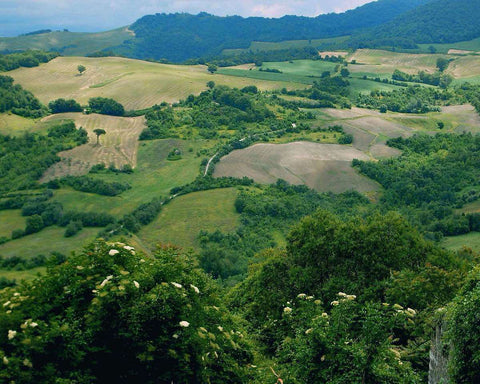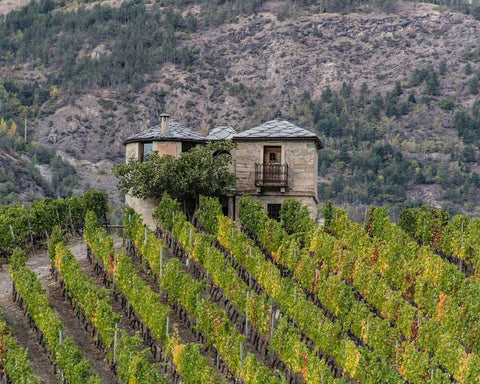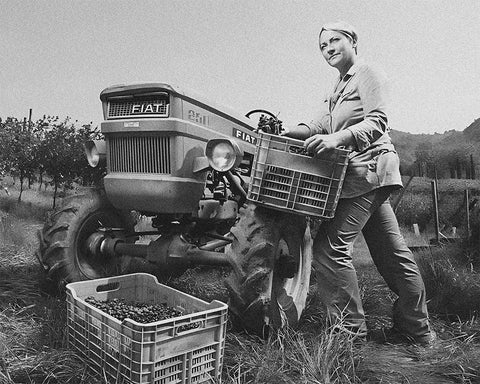Shopping for biodynamic wine and curious how it compares to organic wine and natural wine? This deep dive explains the principles behind biodynamic viticulture, how they translate to the cellar, what these wines taste like, and how to choose great bottles—plus where they fit in your exploration of natural wine, skin-contact white wines, and pét-nat. If you want curated bottles delivered, check out the Primal Natural Wine Club.
What Is Biodynamic Wine?
Biodynamic wine is wine made from grapes grown using biodynamic agriculture, a holistic system that treats the vineyard as a living ecosystem. It goes beyond “no synthetic pesticides or herbicides” (the baseline for organic farming) by emphasizing soil vitality, biodiversity, composting, and farming in rhythm with seasonal and lunar cycles. Many biodynamic producers also pursue low-intervention approaches in the cellar—native yeasts, gentle handling, minimal additives—alongside biodynamic farming.
History & Philosophy
The biodynamic approach grew from early 20th-century lectures on agriculture by Rudolf Steiner and was later adapted to viticulture by growers seeking healthier soils and more expressive wines. The philosophy centers on the idea that a vineyard’s health—its microbial life, plant diversity, insect balance, and soil structure—directly influences grape quality and, ultimately, the authenticity of what’s in your glass.
Core Principles of Biodynamic Viticulture
- Farm as organism: The vineyard functions as an interconnected whole of soil, vines, animals, and people.
- Soil first: Compost, cover crops, and minimal tillage build structure and microbial life.
- Natural rhythms: Key tasks (pruning, racking) often align with seasonal and lunar cycles.
- Homeopathic preparations: Specific plant/mineral/compost preps support soil and plant health.
- Biodiversity: Hedgerows, insectaries, livestock, and mixed plantings promote ecological balance.
Vineyard Practices & Preparations
Biodynamic growers use a toolkit of preparations (often referenced as 500–508) crafted from natural materials like cow manure, silica, and medicinal herbs (yarrow, chamomile, nettle, oak bark, dandelion, valerian). These are composted or fermented and then applied in tiny doses to stimulate soil life and vine resilience.
- Compost & cover crops: Feed soil life, improve structure and water retention, and prevent erosion.
- Minimal tillage: Preserves mycorrhizal networks and carbon in the soil.
- On-farm inputs: Preference for materials grown or produced on the estate for a closed-loop system.
- Integrated animals: Sheep or chickens for mowing and natural fertilization, where feasible.
- Timing: Sprays and tasks may follow lunar/planetary calendars intended to support vine physiology.
Biodynamic preparations in brief: farm-made remedies (500–508) that support soil vitality, vine health, and microbial balance. They’re used in tiny, “catalyst-like” doses and applied to compost or directly to soil and vines.
Field sprays
- 500 (Horn Manure): Cow manure fermented in a cow horn over winter; diluted and sprayed on soil to stimulate microbial life, root growth, and humus formation.
- 501 (Horn Silica): Finely ground quartz fermented in a horn over summer; diluted and sprayed as a fine mist on foliage to enhance light metabolism, aroma definition, and ripening.
Compost preparations
Inserted in tiny amounts into compost piles to guide decomposition and nutrient availability:
- 502 Yarrow: Supports sulfur/potassium dynamics and micronutrient mobility.
- 503 Chamomile: Stabilizes nitrogen and moderates putrefaction.
- 504 Nettle: A metabolic tonic that balances iron and stimulates microbial vigor.
- 505 Oak Bark: Calcium-rich; tempers excessive microbial activity and aids structural stability.
- 506 Dandelion: Aids silica/potassium relations and orderly humus formation.
- 507 Valerian: Mist applied to compost surface; associated with phosphorus flow and frost protection signals.
How growers use them
- Timing: Many tasks follow seasonal and lunar calendars.
- Dose & method: Preparations are “dynamized” (vigorously stirred) and applied at low concentrations by backpack or tractor sprayers.
- Goal: Better soil structure, improved water holding, resilient vines, and fruit that ripens with clarity.
Evidence and practice
Scientific validation varies: some effects (e.g., compost quality, soil biology) are supported by farm trials; others remain debated. Many growers report healthier vines, lower input needs, and more distinctive wines. For buyers, preparations signal that the estate manages soil as a living system—often aligning with minimal-intervention winemaking.
The Cellar: Biodynamic Winemaking
Biodynamic standards primarily govern farming, but many estates carry the same ethos into the cellar. Expect careful hand-sorting, spontaneous fermentations with native yeast, gentle extractions, and thoughtful élevage in neutral vessels that don’t mask terroir. Sulfur (SO₂) additions vary—some use none, others add modest amounts for stability. Clarification and filtration tend to be minimal.
Certifications: Demeter, Biodyvin & More
The most recognized biodynamic certifications in wine are Demeter (international) and Biodyvin (Syndicat International des Vignerons en Culture Bio-Dynamique). Certification audits validate farming methods (and sometimes cellar practices) and allow producers to use the logo on labels. Not all biodynamic growers certify, but certification helps shoppers quickly identify adherence to formal standards when browsing a biodynamic wine collection.
Biodynamic vs. Organic vs. Natural Wine
Organic
- What it governs: Farming inputs
- Key features: No synthetic herbicides, pesticides, or chemical fertilizers
- Cellar implications: Winery rules vary by region; some additives may still be allowed
Biodynamic
- What it governs: Holistic farming system
- Key features: Soil vitality, biodiversity, lunar rhythms, specific preparations
- Cellar implications: Often minimal-intervention; certification available (Demeter/Biodyvin)
Natural
- What it governs: Philosophy spanning farm & cellar
- Key features: Native yeast, low/no additives, unfined/unfiltered common
- Cellar implications: Not legally defined; practices vary by producer
Note: In practice, categories overlap. Many biodynamic wines are also organic and align closely with natural-wine methods. The key is transparency—how clearly a producer communicates what they do in the vineyard and cellar.
Tasting Profile: What Biodynamic Wines Often Taste Like
There’s no single “biodynamic flavor,” in fact, one can argue that well-made conventional wines can taste very similar to well-made biodynamic wines. The main factor is that a wine is well-made. However, drinkers frequently note the clarity of fruit, energetic acidity, and a strong sense of place, which are often lacking in most conventional wines.
Whites can show lifted aromatics and saline precision; reds may lean toward vibrant fruit, fine tannins, and savory depth. In skin-contact whites (orange wine) and pét-nats (pétillant-naturel), expect texture, spice, and vivacious bubbles that feel artisanal rather than factory-perfect. Well-made biodynamic wine tastes great, period.
How to Choose & Buy Biodynamic Wine
- Look for certification: Demeter or Biodyvin logos help you identify vetted producers quickly.
- Read the producer story: Vineyard location, soil, elevation, and farming details are your best guides.
- Start with styles you love: Try biodynamic versions of grapes/regions you already enjoy, then branch out.
- Shop curated collections: Our biodynamic wine collection highlights trusted producers and seasonal favorites.
Storage & Service Tips
- Cellar conditions: 50–57°F (10–14°C) with stable humidity; avoid heat/light swings.
- Serve thoughtfully: Chill whites/rosés; serve lighter reds slightly cool; decant structured reds.
- Let wines open: 10–30 minutes in the glass can reveal layers and finesse.
- Pairing: Fresh, seasonal foods—grilled vegetables, simply prepared seafood, charcuterie, and artisanal cheeses—let biodynamic nuance shine.
FAQ: Common Questions About Biodynamic Wine
Is biodynamic wine healthier?
Biodynamic farming avoids synthetic agrochemicals and emphasizes soil health and biodiversity. Many drinkers choose it for environmental reasons and perceived digestibility, but “healthiness” depends on factors like alcohol level and individual sensitivity.
Does biodynamic wine mean no sulfites?
Not necessarily. Some biodynamic producers add a small, judicious dose of sulfur for stability; others add none. If low or no-added-SO₂ is important, check producer notes or filter for “no added sulfites” within our natural wine selection.
Why do some biodynamic wines taste “alive” or vary bottle to bottle?
Minimal manipulation can reveal micro-differences across lots and vintages. Many enthusiasts value this authenticity—as with sourdough or raw-milk cheeses, variation is part of the charm.
Are all biodynamic wines also natural wines?
No. Biodynamics governs farming; natural winemaking speaks to cellar choices. There’s strong overlap, but each producer’s approach is unique. Read tech notes and tasting descriptions, or explore our curated biodynamic wine collection.










